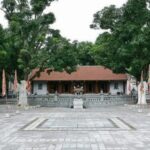Ancient Dong Nhan Temple (also known as Hai Ba Trung Temple) is located at 12 Huong Vien Street (Dong Nhan Ward, Hai Ba Trung District, Hanoi). This is one of the sacred temples worshiping two heroines Trung Trac and Trung Nhi. With unique cultural, historical and architectural values, Dong Nhan Temple, along with communal houses and pagodas, is a relic complex that has been ranked as a Special national relic (in 2020).

The two heroines’ hometown is in Phong Chau, Me Linh. The elder sister is Trung Trac, the younger one is Trung Nhi. At that time, the prefect of the Han Dynasty, To Dinh, brutally murdered Thi Sach, the husband of Trung Trac. The two heroines waved the flag to rebel, and with the people from all over responding together, they defeated To Dinh army to get 65 strongholds in Linh Nam, and proclaimed themselves kings. Later, the Han Dynasty sent general Ma Vien to suppress, the two heroines could not resist and had to withdraw to protect Cam Khe land, finally went to Thuong Son mountain and committed suicide. Another theory says that the two heroines both jumped into the Hat Giang River to commit suicide, then they turned into two white rocks floating on the Red River back to Dong Nhan riverbank, often glowing brightly at night. The villagers took red cloth to pick up their statues and build a temple to worship the two heroines at Dong Nhan beach riverbank.

According to historical records, Hai Ba Trung Temple was built during the reign of King Ly Anh Tong, the third Dai Dinh era (1142), in the riverbank area of Dong Nhan village. Then, because this land was eroded, the villagers moved the temple to Huong Vien village (where it is today). The temple is the center of the relic complex: Vien Minh Pagoda, the temple worshiping Cao Son Dai Vuong, King Thien Tu, Do Ho Dai Vuong and other water gods who have contributed to the residents living along the river. The temple was built on an area of 4,000m2, in the style of “工-shaped inside and 国-shaped outside” architecture. In front of the gate there is a semicircular lake. Going through a path, you will see a large yard with the altar-curtain with 4 pillars. There are a large stele riding a turtle’s back on the left and a two-storeyed eight-roofed communal house. Going inside, there is a 7- compartment “tien te” house with two black painted wooden elephants to which attached two pairs of real ivory. These are two elephants representing the elephants of the two heroines leading the army to battle.
The “tien te” house is connected to the harem by an incense burning court, inside, there is a throne and a mosaic of Hai Ba Trung riding elephants to fight against the enemy. In the harem, the statues of the two heroines are placed on a stone pedestal about 1m high. The statues are made of terracotta with sitting posture. Mrs. Trung Trac wears a yellow shirt, Mrs. Trung Nhi wears a red shirt, wearing “phu dung” hats, the statues are bigger than the real persons, their hands are raised high in front of their face as if they are summoning the masses. On both sides, there are statues of female generals who followed the two heroines to drive To Dinh, remove the national humiliation, and revenge for her husband: Generals Le Chan, Hoa Hoang, Thien Nga, Nguyen Dao Nuong, Phung Thi Chinh, and Princess Pham Thi Con. The altar is placed with a throne and a mosaic showing the image of the two heroines riding elephants to fight against the enemy.
In Dong Nhan Temple, many valuable sacrifices are still preserved, such as: “Bat buu”, diaphragm, couplets dating back to the 19th and early 20th centuries. Dong Nhan Temple also has a stele “Truong Vuong, the story of Inscription” placed in the yard in front of the altar, composed by Dr. Vu Tong Phan in 1840 with the content praising the two heroines as the “Nam bang tiet liet”.
To pay tribute to the merits of the two heroines, every year, the people here hold the Dong Nhan temple festival from February 4 to 7. The main part of festival is held in the 6th with a special art performance program recreating the scene of Hai Ba Trung riding elephants to fight the enemy. The festival is lively with folk games. At 12:00 pm, there is a procession of the master and the sacrificing ceremony of 4 communes to worship Hai Ba Trung, including Phung Cong village (Phung Cong commune, Van Giang district, Hung Yen province), Ha Loi village (Me Linh commune, Me Linh district, Hanoi city) and Hat Mon village (Hat Mon commune, Phuc Tho district, Hanoi city). The festival at Dong Nhan temple shows the principle that” When drinking water, think of its source”, expressing gratitude to national heroes who have contributed to the country and the people.
There are many places to worship Hai Ba Trung such as Hat Mon (Phuc Tho district), Phung Cong (Hung Yen), Me Linh (Me Linh district) and more than four hundred places to worship Hai Ba’s generals but Dong Nhan Temple is still the destination of many tourists all over.
Minh Ngoc

